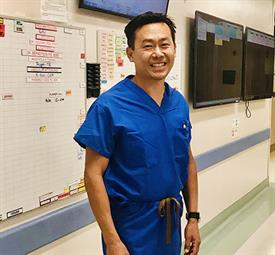New Study Evaluates Hand-Held Device Using Acoustic Energy To Fragment Painful Kidney Stones.
Source: Thailand Medical News Oct 28, 2019 6 years, 2 months, 3 days, 9 hours, 7 minutes ago
University Of California, San Diego Health has started enrolling its first set of patients to evaluate an investigational hand-held technology to non-invasively fragment painful
kidney stones. The clinical trial will assess the safety and effectiveness of breaking up kidney stones using acoustic energy. Unlike traditional shockwave technologies, this next-generation form of
lithotripsy uses cyclic pulses of ultrasound to fracture
kidney stones at lower pressures and potentially with little to no anesthesia.
.jpg)
Developed at UC San Diego Health, Break Wave is a novel investigational device designed to apply burst wave
lithotripsy (BWL) on the skin, either over the kidney or over the ureter. Once positioned, the
kidney stone is located via real-time ultrasound image guidance and a low amplitude burst of sound waves is emitted to fragment the stones, typically composed of hardened calcium oxalate, calcium phosphate, uric acid, or magnesium-ammonium-phosphate..
Pre-clinical studies with a range of probes, interfaces, and outputs demonstrated the feasibility and consistent safety of BWL, which was used painlessly and without adverse events to reposition stones in 14 of 15 human study participants without restrictions on patient size, stone size, or stone location.
An international, multi-center non-randomized clinical trial of the Break Wave device will recruit up to 30 patients with
kidney stones of a diameter up to 20 millimeters, with the primary goal of evaluating the device and to determine if the procedure can be done with minimal or zero anesthesia and in a non-surgical environment.
 Dr. Roger Sur, MD, urologist at UC San Diego Health.
Dr. Roger Sur, MD, urologist at UC San Diego Health.
Urologist Dr Roger Sur, director of the Comprehensive
Kidney Stone Center at UCSDH commented during a phone interview with
Thailand Medical News, “Think of an opera singer hitting the right vocal pitch to produce vibrations that stress and break a wine glass. This is a similar concept. The idea behind this investigational technology is to repeatedly stress certain points in the
kidney stone that cause it to fracture into small fragments, while avoiding damage to surrounding tissue.”
Dr Roger Sur further commented “If this study shows that this technology is both safe and effective in fragmenting
kidney stones and does so with little to no anesthesia,
it could be a game changer for patients. While watchful waiting is a good approach for the majority of
kidney stones, we are in need of more non-invasive technologies that can treat
kidney stones without harming other structures.”
Often
kidney stones are often no larger than a grain of rice, yet some can grow to a diameter of several centimeters, causing blockage of the ureters. If it cannot be dissolved chemically, the kidney stone is treated using extracorporeal shock-wave therapy or minimally invasive endoscopic modalities. Many of these patients suffer from disease recurrence and need retreatment, but new stone formation might be reduced by adapting dietary habits or the use of particular medication strategies, as based on stone composition.
Traditional non-invasive treatment for
kidney stones is called shock wave
lithotripsy. This therapy uses high amplitude shock waves to break up stones. Shock wave lithotripsy often requires the use of x-ray imaging to target the stone, anesthesia, and higher pressures as compared to the Break Wave device. Complications related to these procedures include hematomas, urinary tract injury or obstruction.
Kidney stone disease, also known as
nephrolithiasis, is a common problem worldwide, with a prevalence of 7% in the adults, and ≥30% recurrence rate within 10 years. The incidence of
kidney stones is globally increasing with an estimated prevalence ranging up to 15%. In the US alone it affects 13 percent of men and 7 percent of women in the United States, and the rate of recurrence is about 50 percent within five years, and 80 percent within 10 years.
.jpg)
